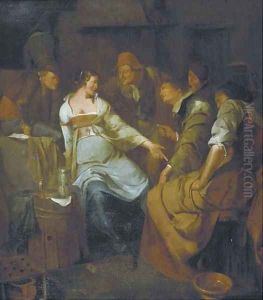Jacob Van Ochtervelt Paintings
Jacob Van Ochtervelt was a Dutch painter who specialized in genre scenes and portraits, active during the Dutch Golden Age of painting. Born in 1634 in Rotterdam, Netherlands, Ochtervelt is known for his skillful depiction of the elegant life of the Dutch middle and upper classes.
Ochtervelt’s works are characterized by their vibrant colors, sophisticated lighting, and keen observation of textures and fabrics. He often depicted scenes of music-making, elegant company, and domestic activities, where the interaction between figures and the sumptuousness of their surroundings was emphasized. His paintings are notable for their depiction of the textures of materials, such as satin and fur, and the interplay of light and shadow.
While his early work was influenced by fellow Dutch painters like Pieter de Hooch, Ochtervelt later developed his own distinctive style. He moved to Amsterdam sometime in the 1660s, which was a common practice among artists of the time seeking to expand their patronage. In Amsterdam, Ochtervelt continued to refine his style, and his paintings from this period show a greater emphasis on elegance and refinement.
Despite his success, not much is known about Ochtervelt’s life, and he remained relatively unrecognized until the 20th century when there was a renewed interest in Dutch genre painters. His works are now held in high regard, and they can be found in major museums around the world, including the Rijksmuseum in Amsterdam, the National Gallery in London, and the Metropolitan Museum of Art in New York.
Jacob Van Ochtervelt died in 1682 in Amsterdam. His legacy is a collection of beautifully rendered scenes that provide a window into the life of the Dutch bourgeoisie during the 17th century, showcasing their interiors, customs, and fashions with an exquisite eye for detail.
